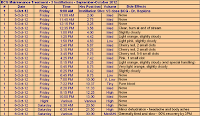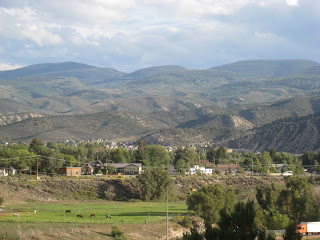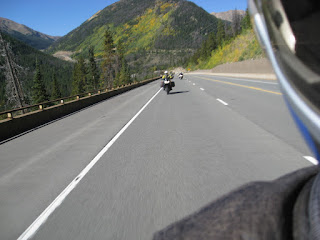In a few previous posts I have mentioned "El Caligrafo" which may be translated "The Calligrapher," or perhaps more accurately "The Scribbler." Despite the appearances he is not actually Batman's latest Latin nemesis, but rather a really great fellow named Sebastián B. from Argentina. His nickname comes from his hobby as an amateur writer of fiction. He and I have a lot in common: married (over 20 years), no children, loves dogs, loves travel, works in engineering (civil), has a great sense of humor, and bladder cancer. His wife, Marisa, is also an engineer (systems). He also used to refer to himself as Oldman, but at only 45 he is a bit younger than me, so there will be no further reference to that!
Sebastián and Marisa live in Rosario, the second largest city in Argentina with over a million population, located about 300km (188 miles) from the capital city of Buenos Aires. He sent me a few official photos of the city:
They are in the middle of summer now in the Southern Hemisphere, and the family has just completed a nice Carnival holiday at nearby Victoria. Even their dog, Chiche was able to go with them. According to Sebastián, Chiche (pictured below) is "not precisely a Rottweiler," and he loves to ride in the car!

The protocol for bladder cancer treatment in Argentina is quite similar to the US standard of care. Diagnosis with urine test, ultrasound, x-ray, and cystoscopy, then TURBT surgery (one or more), and then BCG treatments with cystoscopy inspection for life. One difference is that routine bladder biopsies are performed after BCG - 15 samples! Sebastián initially contacted me with a few suggestions. He has independently adopted a similar attitude to mine regarding diet and lifestyle changes. Sebastian's diet is covered in this post. Another suggestion concerned relaxation before scopes and other procedures. Sebastián has found daily, low-dose (75mg) pregabalin (sold in the US under the brand name Lyrica) to be quite effective in taking the "edge" off pre-procedure anxiety. He has found no side-effects, drowsiness, or difficulty concentrating,and he offers this following item from Medscape Medical News as support:
Pregabalin Safe, Effective in Generalized Anxiety Disorder
Laurie Barclay, MD
March 7, 2003
Pregabalin was safe and effective in treating generalized anxiety disorder, according to the results of a placebo-controlled trial reported in the March issue of the American Journal of Psychiatry. This drug was almost as effective as benzodiazepines without withdrawal symptoms, making it a potentially good alternative. It may also be beneficial in a number of other neuropsychiatric disorders.
"Recent attempts to develop nonbenzodiazepine anxiolytic agents with novel mechanisms have been mostly unsuccessful," write Atul C. Pande, MD, FRCPC, from Pfizer Global Research and Development at Ann Arbor Laboratories in Michigan, and colleagues. "One novel agent, pregabalin, a structural analogue of gamma-aminobutyric acid (GABA), is currently in development as an anxiolytic on the basis of its profile of pharmacologic activity in animal behavioral models."
In this double-blind study, 276 patients meeting DSM-IV criteria for generalized anxiety disorder were randomized to treatment with pregabalin (150 mg/day or 600 mg/day), lorazepam (6 mg/day), or placebo. Some subjects had mild depressive symptoms, but patients with other comorbid psychiatric disorders were excluded. After a one-week placebo lead-in, subjects received four weeks of treatment followed by a one-week dose taper.
Mean decreases in total Hamilton anxiety scale score from baseline to endpoint for each group were –9.2 for pregabalin 150 mg/day, –10.3 for pregabalin 600 mg/day, and –12.0 for lorazepam, which were significantly greater than –6.8 for placebo. Pregabalin's effect on the total Hamilton anxiety scale score began as early as week 1.
Compared with the other groups, fewer patients in the lorazepam group completed the trial (59% vs. 73% for placebo, 71% for 600 mg/day pregabalin, and 90% for 150 mg/day pregabalin.) Somnolence and dizziness were the most frequent adverse events reported for pregabalin and lorazepam. No patients receiving pregabalin reported serious adverse events or had evidence of withdrawal syndrome.
"These results indicate that pregabalin is an effective, rapidly acting, and safe treatment for generalized anxiety disorder," the authors write. "In short-term treatment, pregabalin does not appear to have the withdrawal symptoms associated with the benzodiazepines.... Pregabalin is also currently under study for treatment of seizure disorders and neuropathic pain [and it] may have activity in several nervous system disorders other than anxiety."
Am J Psych. 2003;2160:533-540
Reviewed by Gary D. Vogin, MD
I have not tried it, as I tend to be on-edge pretty much all the time,
so for me the pre-procedure times are simply a matter of degree. Ever the creative optimist, Sebastián suggests a slightly more complex alternative which I can wholeheartedly endorse, involving a tropical island, beach, good weather, and perhaps some ethanol. The photo below shows Sebastián demonstrating this alternate relaxation technique:
Sebastián has also had some benefit from adding ultrasound checks between cystoscopy, just to add peace of mind. I shared that ultrasound had not detected anything in my case, but perhaps it cannot hurt to check. On the other hand, about 3 months after cystoscopy and biopsies came back all clear, Sebastián went in for a precautionary ultrasound that detected a large (8mm) spherical intrusion into the bladder. Look at the center right side of each photo below - this thing looks huge!

Rather than adding peace of mind, the effect was opposite. Can you imagine the growth rate of something that size forming after only 3 months? The doctors told him it could be a "blister," a harmless byproduct of the biopsies, or it could be a tumor. A TURBT was scheduled for the day after Christmas last year. On January 3 he got the good news. The "tumor" was an inflammation of the bladder wall caused by the previous TUR surgery and biopsy. Supposedly a rare phenomenon, it is completely benign. God is indeed good, ALL THE TIME. Sebastián wanted me to post the details here so that others may know that not everything detected after surgery is a problem.
Other advice from Sebastián concerns post-TURBT recovery. Super-hydration (4+ litres/day), avoid spicy foods or other dietary irritants (citrus and other things high in vitamin C), and chamomile tea.
I want to thank Sebastián and Marisa for sharing his information with us all, and I hope that he can remain cancer-free. Perhaps we can meet on some tropical island some time to practice our relaxation techniques!
 It's been almost 3 weeks since my final BCG treatment of the last maintenance series, and I have been remiss in updating the blog with data and details. I must emphasize that moderating my fluid intake and adding Gatorade as an electrolyte replacement has made an enormous difference in dealing with the side effects. My "drink more, then drink more still" strategy definitely created more problems with electrolyte loss than it solved by flushing the bladder. I target about 1.5 - 2 quarts of fluid (black tea at room temperature for me) per hour after the first two hours to continue until major symptoms cease - sometimes well after the 6 hour special handling period. I intersperse mouthfuls of Gatorade beginning at about 3 hours after instillation, targeting about 2 quarts of Gatorade consumed across the time period. I also sip a little more Gatorade during the night, and pound down at least half a quart upon arising the next day. Net result is lower symptoms, lower duration, and less total discomfort. I no longer need to plot a "misery index," as the net misery is now less than it has been for the past 2 years.
It's been almost 3 weeks since my final BCG treatment of the last maintenance series, and I have been remiss in updating the blog with data and details. I must emphasize that moderating my fluid intake and adding Gatorade as an electrolyte replacement has made an enormous difference in dealing with the side effects. My "drink more, then drink more still" strategy definitely created more problems with electrolyte loss than it solved by flushing the bladder. I target about 1.5 - 2 quarts of fluid (black tea at room temperature for me) per hour after the first two hours to continue until major symptoms cease - sometimes well after the 6 hour special handling period. I intersperse mouthfuls of Gatorade beginning at about 3 hours after instillation, targeting about 2 quarts of Gatorade consumed across the time period. I also sip a little more Gatorade during the night, and pound down at least half a quart upon arising the next day. Net result is lower symptoms, lower duration, and less total discomfort. I no longer need to plot a "misery index," as the net misery is now less than it has been for the past 2 years.
























































